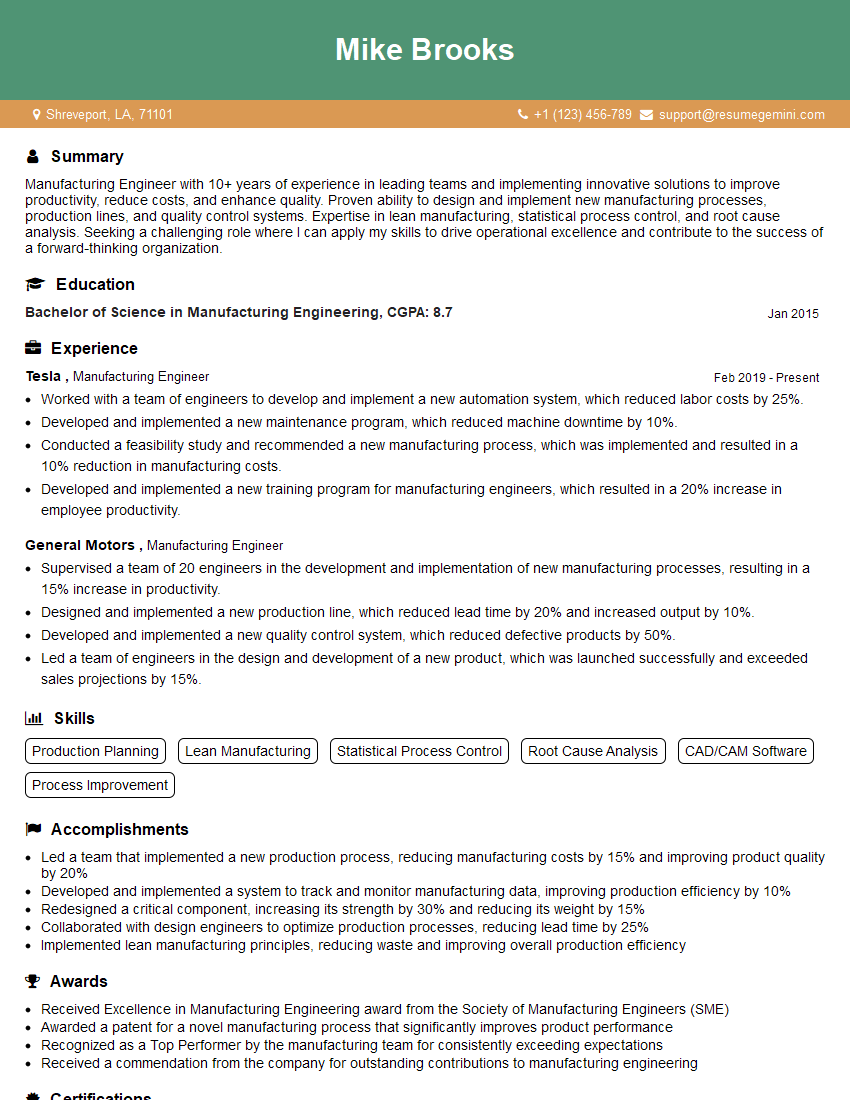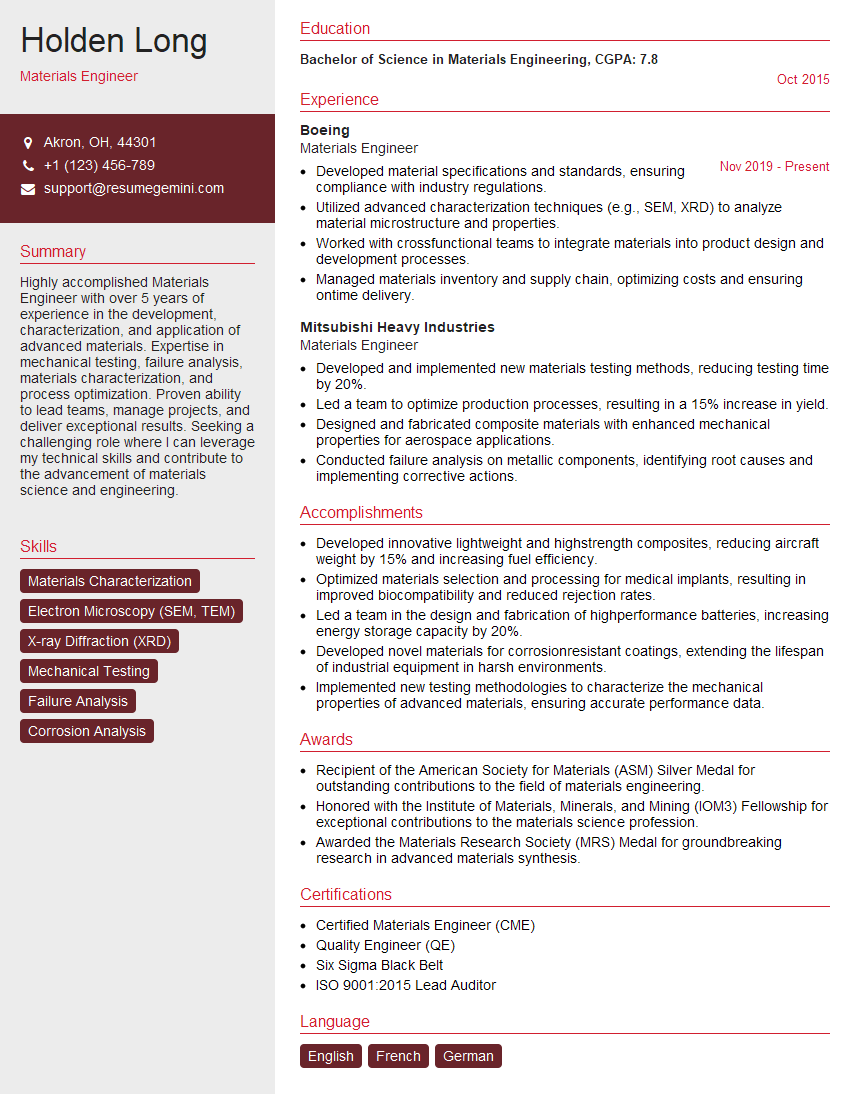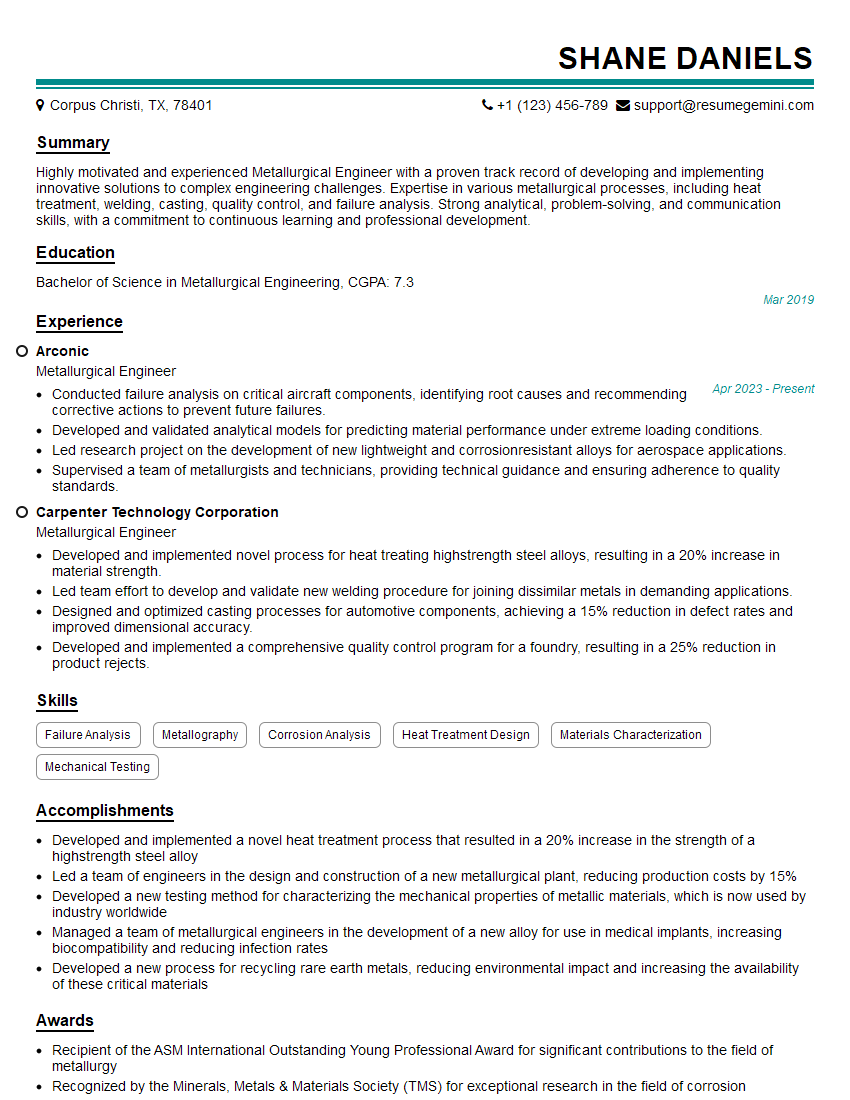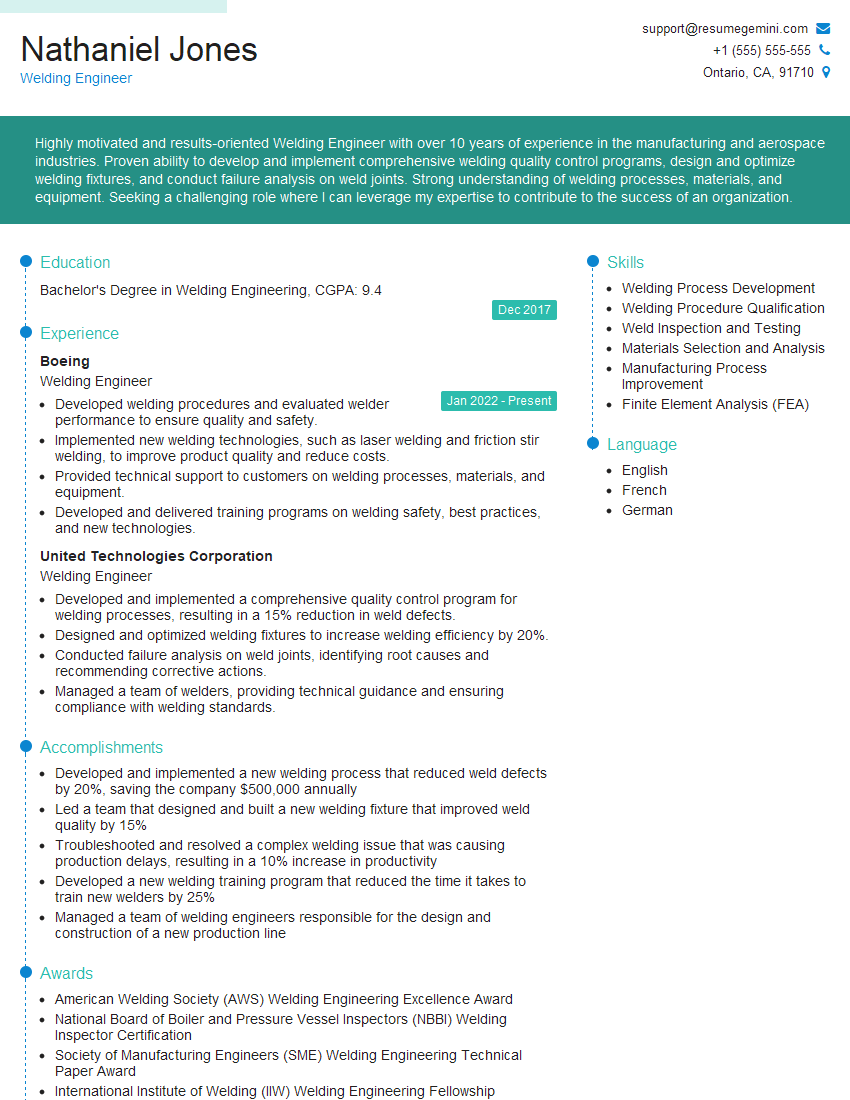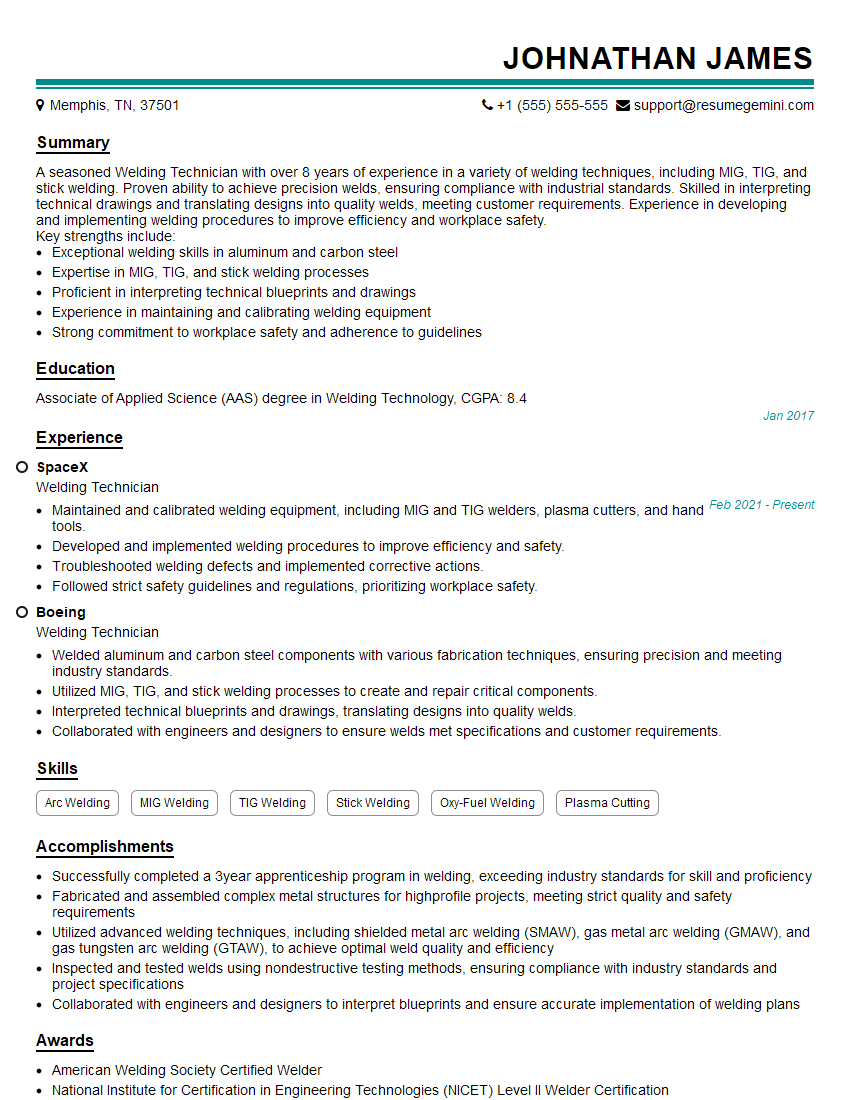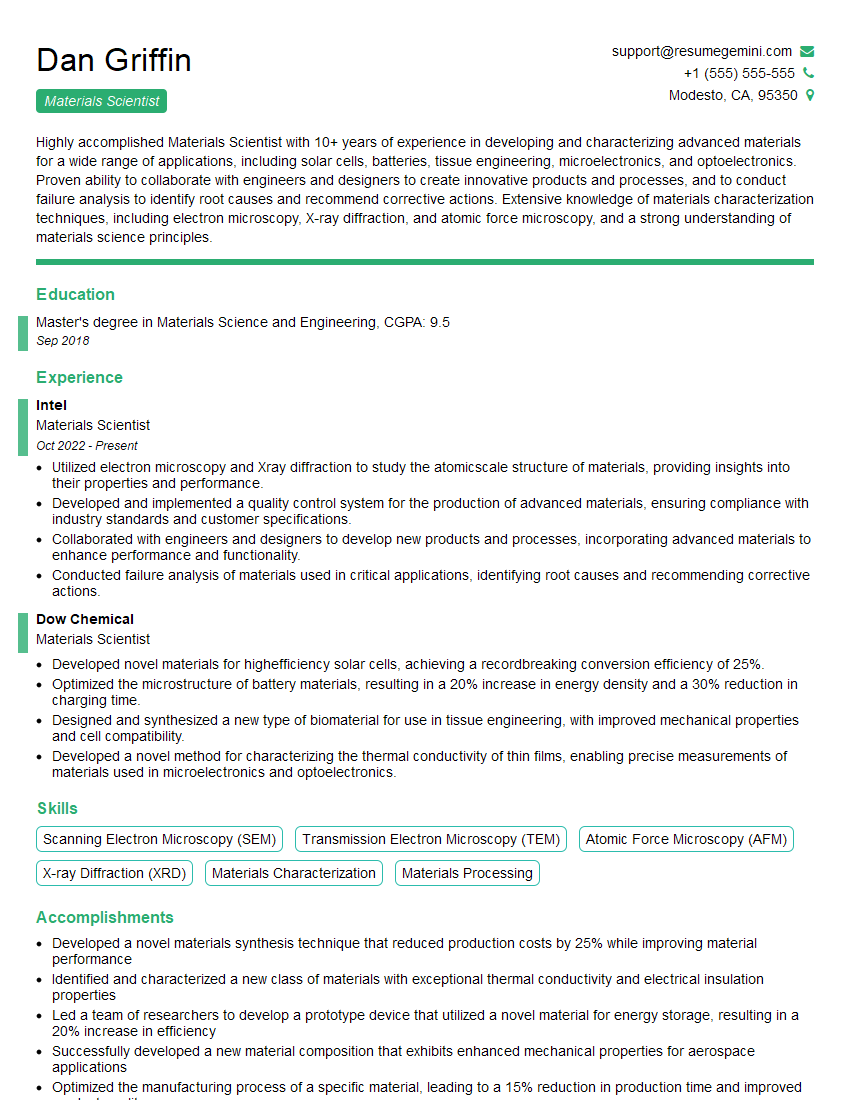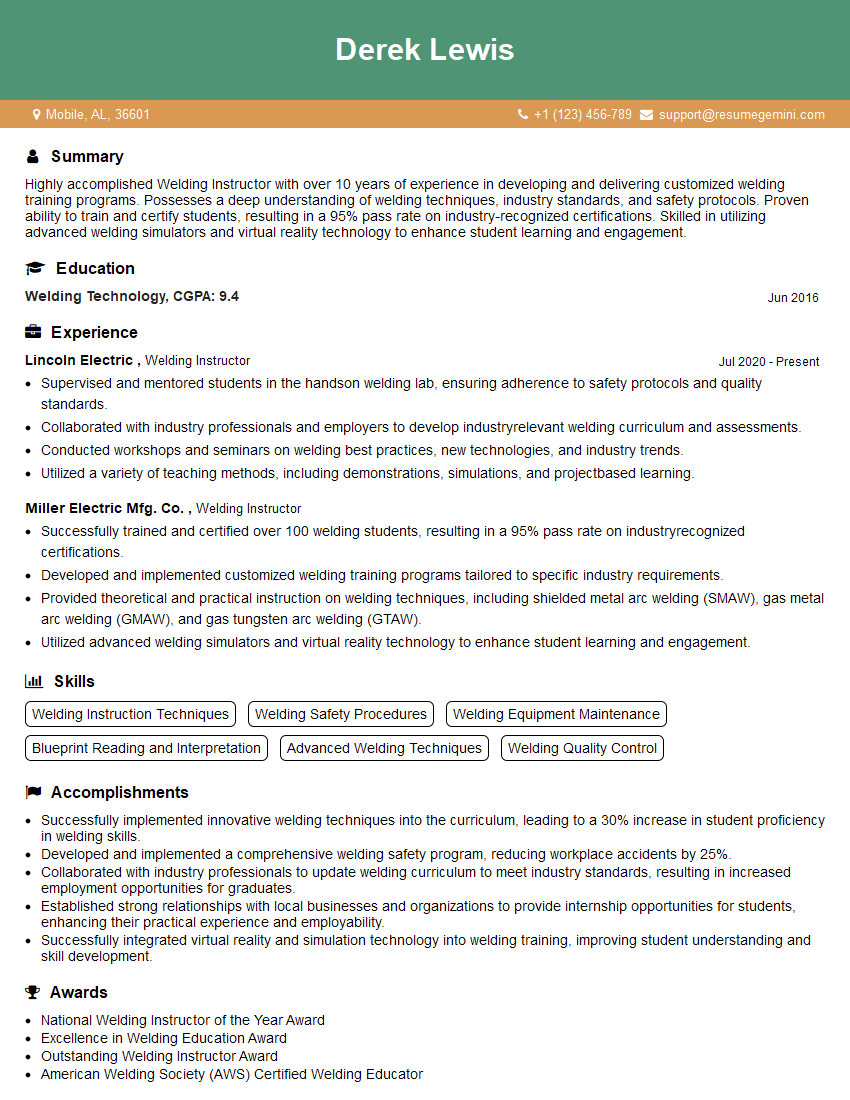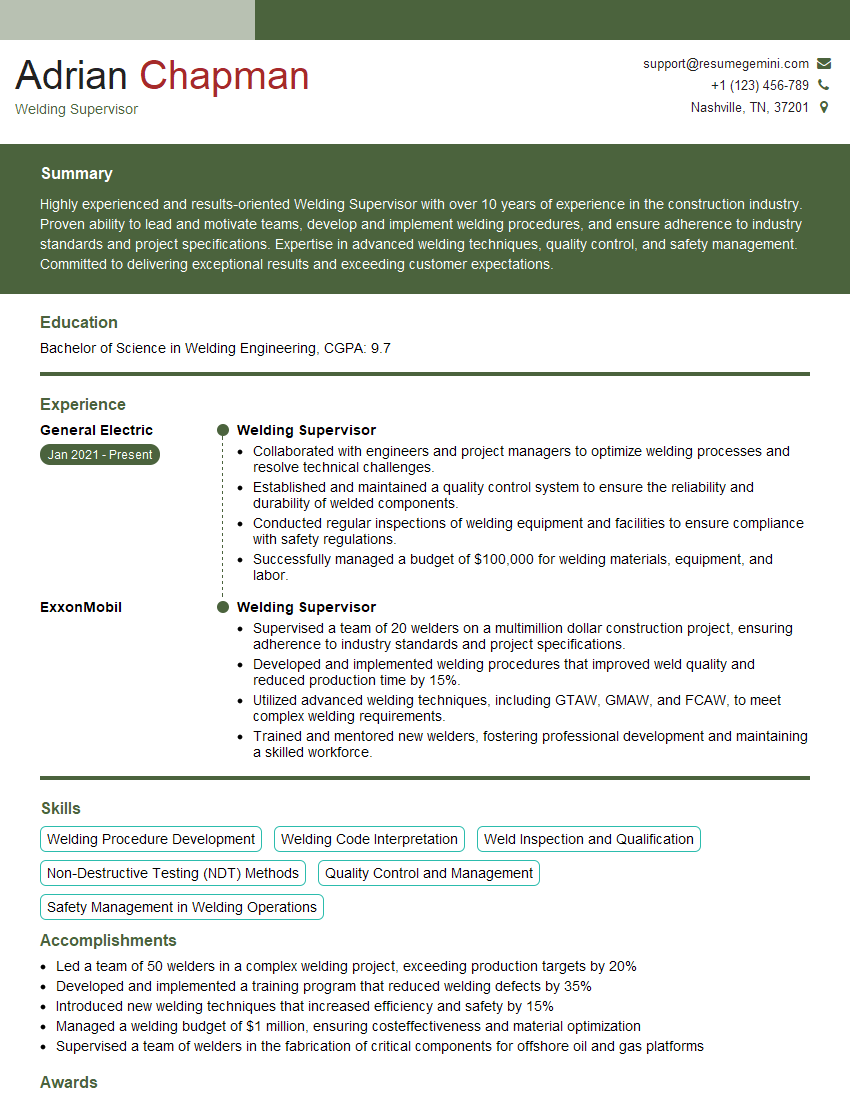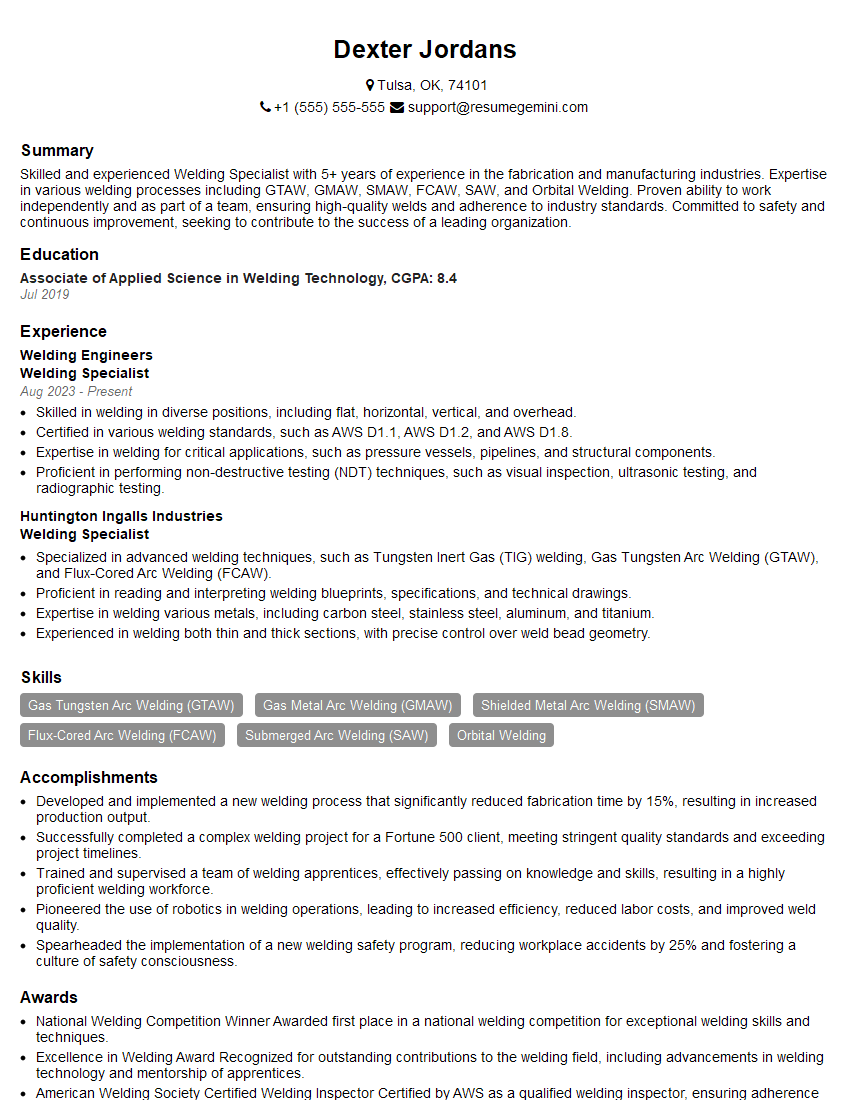The right preparation can turn an interview into an opportunity to showcase your expertise. This guide to Filler Metal Selection and Application interview questions is your ultimate resource, providing key insights and tips to help you ace your responses and stand out as a top candidate.
Questions Asked in Filler Metal Selection and Application Interview
Q 1. Explain the difference between SMAW, GMAW, and GTAW filler metals.
The primary difference between SMAW (Shielded Metal Arc Welding), GMAW (Gas Metal Arc Welding), and GTAW (Gas Tungsten Arc Welding) filler metals lies in their form and how they’re applied. Think of it like using different writing instruments: each has its strengths and weaknesses for a particular task.
- SMAW: Uses solid filler metal in the form of a coated electrode (stick). The coating provides shielding gas and flux, adding elements to improve weld properties. It’s robust and portable, ideal for outdoor or remote work, but less precise than other methods.
- GMAW (MIG): Employs a continuously fed solid wire electrode. Shielding gas (often CO2 or Argon mixes) protects the weld puddle. It’s faster and more efficient than SMAW, producing cleaner welds, but requires specialized equipment.
- GTAW (TIG): Utilizes a non-consumable tungsten electrode. Filler metal is added separately as a rod. This method offers excellent control and precision, resulting in high-quality welds, particularly on thin materials. However, it’s generally slower and requires more skill.
The filler metals themselves will differ in chemical composition based on the welding process to optimize performance. For example, SMAW electrodes often have a higher manganese content compared to GMAW wires to compensate for the fluxing action of the coating.
Q 2. What factors influence the selection of a filler metal for a specific application?
Selecting the right filler metal is crucial for weld quality and structural integrity. The choice depends on several factors, acting like puzzle pieces that must fit together perfectly.
- Base Metal: The filler metal’s chemistry must be compatible with the base metal to prevent cracking, porosity, or other defects. Welding steel requires steel filler metal; welding aluminum requires aluminum filler metal, and so on. The specific grade of steel or aluminum also impacts the filler metal choice.
- Weld Joint Design: A fillet weld has different requirements compared to a butt weld. The joint’s geometry influences the required weld metal properties.
- Welding Process: As mentioned previously, different processes (SMAW, GMAW, GTAW) use different filler metal forms. The filler metal must be compatible with the process’s characteristics (e.g., wire feed speed in GMAW).
- Required Weld Properties: The application dictates the desired properties. Do you need high strength, corrosion resistance, ductility, or specific impact resistance? The filler metal must meet these requirements.
- Environmental Conditions: If the weld will be exposed to harsh environments (e.g., corrosive chemicals, extreme temperatures), the filler metal should provide enhanced protection.
For instance, welding stainless steel requires a filler metal with similar chromium and nickel content to maintain corrosion resistance. Welding high-strength steels necessitates a filler metal with high yield strength and appropriate toughness.
Q 3. How do you determine the appropriate preheat temperature for a given welding process and material?
Preheat temperature is critical, particularly for thicker materials and those susceptible to cracking. It’s like preheating an oven before baking a cake – it ensures even cooking (welding) and prevents cracking.
Determining the appropriate preheat temperature is usually found in welding procedure specifications (WPS) or codes based on:
- Base Metal: Higher carbon steels and some alloys require preheating to reduce the cooling rate, minimizing the risk of hydrogen cracking.
- Thickness: Thicker sections require higher preheat to manage the heat input and avoid rapid cooling. This prevents stress concentrations and cracking.
- Welding Process: Different processes introduce varying levels of heat input, affecting the required preheat. SMAW, with its relatively lower heat input, might need more preheat compared to GMAW.
- Ambient Temperature: Cold weather might necessitate a higher preheat to compensate for the lower initial temperature of the base metal.
The preheat temperature is usually measured with a contact thermometer, ensuring uniform temperature distribution across the weld area. Many WPS define a specific preheat range (e.g., 150-200°F). Improper preheat can lead to brittle welds prone to cracking.
Q 4. Describe the importance of filler metal chemistry in achieving desired weld properties.
Filler metal chemistry is the backbone of weld quality. It’s the recipe that determines the final product’s taste and texture. The chemical composition significantly influences:
- Mechanical Properties: Elements like carbon, manganese, and silicon affect tensile strength, yield strength, ductility, and hardness. Higher carbon content increases strength but reduces ductility, for example.
- Microstructure: The chemical composition determines the weld’s microstructure (e.g., grain size, phase distribution), which directly impacts its mechanical and corrosion properties.
- Weldability: Certain elements can improve or hinder weldability. For example, sulfur can cause hot cracking.
- Corrosion Resistance: For stainless steel, the chromium and nickel content in the filler metal determines the corrosion resistance of the weld.
For instance, selecting a filler metal with higher nickel content improves the weld’s toughness and corrosion resistance in cryogenic applications. Conversely, a filler metal with higher manganese content can enhance the weld’s strength at elevated temperatures. A mismatch in chemistry can lead to poor weldability and inferior mechanical properties.
Q 5. What are the common defects associated with improper filler metal selection?
Improper filler metal selection can result in a range of weld defects, each with its own impact on structural integrity.
- Porosity: Gas entrapment during welding leads to small holes within the weld, weakening it and potentially causing leaks. This is often caused by moisture in the electrode or shielding gas contamination.
- Cracking: Hydrogen embrittlement or solidification cracking can occur due to incompatible filler metal chemistry or insufficient preheating. Cracks significantly compromise the weld’s strength.
- Lack of Fusion: This results from poor wetting of the base metal by the filler metal. It leaves unwelded areas, reducing the weld’s strength and causing potential failure points.
- Undercutting: Excessive heat input can melt away the base metal, creating grooves alongside the weld, which reduces strength and can cause stress concentrations.
- Inclusions: Foreign materials (slag, oxides) trapped within the weld weaken it and can lead to brittle failure.
These defects can lead to significant safety hazards and economic losses, especially in critical applications like pipelines, bridges, and pressure vessels. Thorough inspection and quality control are crucial to mitigate these risks.
Q 6. How do you identify and address porosity in a weld?
Porosity, those pesky tiny holes, is usually detected visually after welding, but sometimes requires more advanced techniques.
Identification:
- Visual Inspection: A careful visual examination, often using magnification, can reveal surface porosity.
- Liquid Penetrant Testing (LPT): A dye penetrant can highlight surface-connected pores.
- Radiographic Testing (RT): X-rays or gamma rays can detect internal porosity.
- Ultrasonic Testing (UT): High-frequency sound waves can detect both surface and internal pores.
Addressing Porosity: The best approach is prevention, addressing issues like moisture control, proper shielding gas coverage, and correct welding parameters. If porosity is discovered, the remedy depends on its severity and location.
- Minor Surface Porosity: Grinding or machining might be sufficient to remove the affected area.
- Significant Porosity: The weld may need to be repaired or entirely removed and rewelded, ensuring the root cause has been identified and corrected.
Remember, addressing porosity is a delicate balance between removing the defect and avoiding further weakening of the weld.
Q 7. Explain the role of AWS classification in filler metal selection.
The American Welding Society (AWS) classification system provides a standardized way to identify filler metals. It’s like a universal language for welders, ensuring everyone understands the material’s composition and properties.
The AWS classification uses a specific code, for example, E7018. Each part of the code provides crucial information:
- E: Indicates that it’s an electrode (filler metal).
- 70: Represents the minimum tensile strength of the weld metal in ksi (thousands of pounds per square inch). So, E7018 has a minimum tensile strength of 70 ksi.
- 1: Indicates the welding position (1 for all positions). Other numbers represent specific position capabilities.
- 8: Represents the type of coating and its performance characteristics (e.g., low-hydrogen coating).
This standardized classification allows welders to easily select the appropriate filler metal based on the required strength, welding position, and other parameters without ambiguity. It’s an essential tool for ensuring the right material is used for the job and is key to safety and quality in the welding industry.
Q 8. What are the consequences of using the wrong filler metal?
Using the wrong filler metal can have severe consequences, potentially leading to catastrophic failure of the weld joint. The consequences depend on the mismatch between the filler metal and the base material. For example, using a filler metal with incompatible chemical composition can result in:
- Reduced Weld Strength: The weld may be significantly weaker than the base metal, making the structure susceptible to cracking or failure under stress.
- Weld Cracking: Incompatible filler metals can cause various types of cracking, including hot cracking during solidification and cold cracking after cooling. This is often due to differences in thermal expansion coefficients and metallurgical incompatibilities.
- Porosity and Inclusions: The weld might contain pores (gas bubbles) or inclusions (foreign materials) that weaken it and reduce its fatigue resistance.
- Corrosion: A mismatch can lead to galvanic corrosion, where the weld acts as an anode, accelerating its deterioration.
- Embrittlement: The weld metal might become brittle, losing its ductility and making it more prone to fracture.
Imagine building a bridge – you wouldn’t use weak or mismatched materials! The same principle applies to welding. The wrong filler metal compromises the structural integrity of the entire weldment.
Q 9. How do you ensure the proper storage and handling of filler metal?
Proper storage and handling of filler metal is crucial to maintain its quality and ensure safe usage. Here’s how to do it:
- Storage Environment: Filler metals, especially those sensitive to moisture, should be stored in a dry, clean environment with a stable temperature. Avoid areas with high humidity or exposure to extreme temperature fluctuations. Dampness can lead to oxidation and corrosion.
- Packaging: Keep the filler metal in its original packaging until needed. This helps prevent contamination and protects it from damage. Once opened, seal it tightly to maintain its integrity.
- Protection from Contamination: Keep the filler metal away from dirt, grease, oil, and other contaminants which could compromise its weldability and quality.
- FIFO (First-In, First-Out): Follow a FIFO system when using filler metals from stock. Use the oldest materials first to minimize degradation and prevent wastage.
- Handling Precautions: Handle filler metal with care to avoid damage. Protect the wire from sharp bends or kinks that can cause cracks or weaken its structure.
Think of it like storing perishable goods. If you leave your groceries out in the sun, they’ll spoil. Similarly, improper storage of filler metal leads to its deterioration, impacting the quality of welds.
Q 10. Describe the different types of filler metal coatings and their purposes.
Filler metal coatings serve important functions in enhancing the welding process and the resulting weld properties. Different coatings cater to different needs.
- Copper Coating: Improves conductivity, particularly useful for Gas Metal Arc Welding (GMAW) to ensure consistent arc stability and prevent sticking.
- Zinc Coating: Offers corrosion protection, often used in applications requiring resistance to rust or other environmental factors.
- Flux Coating: Contains chemicals that help remove oxides and contaminants from the base metal surface, promoting better weld penetration and quality. Flux-cored wires rely heavily on this for shielding the weld puddle.
- Organic Coatings: Can include lubricants to improve wire feeding in automatic welding systems, or other additives to enhance certain welding characteristics.
The type of coating used depends heavily on the specific application and welding process. A copper-coated wire is ideal for high-speed GMAW, whereas a flux-cored wire is chosen for its self-shielding properties in environments where external shielding gas might not be suitable.
Q 11. What are the safety precautions associated with handling and using filler metals?
Safety is paramount when handling and using filler metals. Here are crucial precautions:
- Eye and Face Protection: Always wear appropriate eye and face protection, such as a welding helmet with appropriate shade, to prevent injury from intense light and spatter.
- Respiratory Protection: Fumes generated during welding can be hazardous. Use respiratory protection, such as a respirator, when necessary, particularly when working in enclosed spaces or with specific filler metals.
- Protective Clothing: Wear flame-resistant clothing to protect against burns and spatter. Gloves and high-top boots also provide protection against molten metal and sharp objects.
- Proper Ventilation: Ensure adequate ventilation to remove harmful fumes from the welding area. In confined spaces, use extraction systems to remove fumes effectively.
- Fire Safety: Keep fire extinguishers nearby and be aware of fire hazards associated with welding. Ensure that flammable materials are kept a safe distance away.
- Handling Precautions: Avoid dropping or mishandling the filler metal to prevent injury.
Welding is inherently risky. Never compromise on safety procedures – it could prevent serious injury or even save your life.
Q 12. How do you interpret a welding procedure specification (WPS)?
A Welding Procedure Specification (WPS) is a document outlining the parameters for a specific welding process to achieve a consistently high-quality weld. Interpreting it involves understanding various aspects:
- Base Materials: The WPS specifies the type, grade, and thickness of the base materials to be welded.
- Filler Metal: The WPS clearly indicates the type, grade, and manufacturer of the approved filler metal. It will also list the required filler metal diameter.
- Welding Process: The WPS defines the welding process employed (e.g., GMAW, SMAW, etc.).
- Welding Parameters: This includes critical parameters like voltage, amperage, travel speed, wire feed speed (for GMAW), and preheat temperature.
- Joint Design and Preparation: The WPS describes the type of joint (butt, fillet, etc.), the joint preparation (bevel angles, root opening), and any specific surface treatments required.
- Post-Weld Heat Treatment (PWHT): The WPS may specify if PWHT is required, along with the necessary temperature and time parameters.
- Qualification: The WPS will refer to the welder’s qualifications and the procedure qualification record (PQR), which documents the testing and qualification of the welding procedure.
Think of the WPS as a recipe for making a weld. Following the instructions carefully ensures a consistent and high-quality end product.
Q 13. How do you qualify a new filler metal for a specific application?
Qualifying a new filler metal involves a rigorous process to verify its suitability for a specific application. This usually involves:
- Mechanical Testing: Conduct tensile, bend, and impact tests on weld samples to evaluate the mechanical properties (strength, ductility, toughness) of the welds made with the new filler metal.
- Macro and Micro Examination: Visual inspection and microscopic analysis of the weld metal are performed to assess the weld structure, identify any defects (porosity, cracks, inclusions), and evaluate the grain size.
- Chemical Analysis: Analyze the chemical composition of the weld metal to ensure it meets the required specifications.
- Weldability Testing: Assess the ease of welding with the new filler metal under the intended welding parameters.
- Corrosion Testing: Conduct corrosion tests, such as salt spray testing, if corrosion resistance is a critical requirement for the application.
- Documentation: Meticulously document all testing procedures, results, and observations.
This ensures that the new filler metal meets the necessary standards and can reliably produce high-quality welds for the specific application. Failure to qualify a filler metal properly can have serious safety and reliability implications.
Q 14. Explain the difference between solid and flux-cored wire.
The main difference between solid wire and flux-cored wire lies in their composition and how they operate in the welding process.
- Solid Wire: Solid wire is simply a metal wire of the filler metal composition. It relies on a shielding gas (like argon or CO2) to protect the weld puddle from atmospheric contamination. The shielding gas is fed separately into the welding torch.
- Flux-Cored Wire: Flux-cored wire contains a flux core inside the metal wire. This flux core contains materials that act as a shielding agent (preventing oxidation), deoxidizers (removing oxygen from the weld puddle), and alloying elements (influencing the weld metal composition). This allows for welding with less reliance on external shielding gas, or in some cases, no shielding gas at all.
Think of it like this: solid wire needs a separate protective ‘blanket’ (shielding gas), while flux-cored wire has its own built-in ‘protective coating’ (the flux core). This makes flux-cored wire particularly useful in situations where shielding gas is impractical or unavailable, such as outdoor welding or welding in windy conditions.
Q 15. What are the advantages and disadvantages of using different filler metal types (e.g., solid wire, flux-cored wire, electrodes)?
Choosing the right filler metal is crucial for a successful weld. Each type offers unique advantages and disadvantages. Let’s compare solid wire, flux-cored wire, and electrodes:
- Solid Wire:
- Advantages: Good arc stability, high deposition rates, versatility in various welding processes (GMAW, GTAW). Easier to control for precise welds.
- Disadvantages: Requires shielding gas (usually argon or a mixture), susceptible to atmospheric contamination if shielding is compromised.
- Flux-cored Wire:
- Advantages: Self-shielding, can be used in outdoor environments without shielding gas, good for welding in all positions, often incorporates alloying elements directly into the flux core enhancing weld properties.
- Disadvantages: Higher spatter levels compared to solid wire, can produce more fumes, potentially leading to slower deposition rates depending on the type of flux.
- Electrodes (SMAW):
- Advantages: Simple setup and portable, versatile in different positions, can weld in various environments, many electrode types are available offering various mechanical properties to be selected for specific applications.
- Disadvantages: Lower deposition rates than wire processes, requires skill to maintain a consistent arc, slag removal after welding can be time-consuming, not suitable for all materials.
For example, a structural steel fabricator might prefer flux-cored wire for its ease of use and portability in the field, while a precision welder working on thin stainless steel might opt for solid wire with argon shielding for superior control and minimal spatter.
Career Expert Tips:
- Ace those interviews! Prepare effectively by reviewing the Top 50 Most Common Interview Questions on ResumeGemini.
- Navigate your job search with confidence! Explore a wide range of Career Tips on ResumeGemini. Learn about common challenges and recommendations to overcome them.
- Craft the perfect resume! Master the Art of Resume Writing with ResumeGemini’s guide. Showcase your unique qualifications and achievements effectively.
- Don’t miss out on holiday savings! Build your dream resume with ResumeGemini’s ATS optimized templates.
Q 16. How does the diameter of filler metal affect weld penetration?
The diameter of the filler metal significantly influences weld penetration. A larger diameter filler metal generally leads to greater heat input per unit length of weld, resulting in deeper penetration. This is because a larger diameter provides a larger cross-sectional area of molten filler metal, thus conducting more heat into the base material.
Think of it like this: A larger diameter wire is like a wider hose—it allows a larger volume of water (heat) to flow. Conversely, a smaller diameter wire acts like a narrow hose, providing less heat input and therefore shallower penetration.
However, this relationship isn’t linear. Other factors such as welding current, voltage, travel speed, and joint design also play crucial roles. Excessive penetration can lead to burn-through, while insufficient penetration results in weak welds. Selecting the appropriate diameter requires careful consideration of the material thickness and desired weld properties.
Q 17. How do you select filler metal for dissimilar metal welding?
Welding dissimilar metals presents unique challenges because of differences in melting points, thermal expansion coefficients, and chemical reactivity. Filler metal selection for such applications is critical to avoid cracking, corrosion, or other weld defects. The key strategy is to choose a filler metal that is chemically compatible with both base metals and whose melting point lies between those of the two base metals.
The selection process often involves consulting manufacturer’s data sheets and welding handbooks that provide pre-qualified filler metal recommendations. For example, when welding steel to stainless steel, you would not use a standard carbon steel filler metal. Instead, you would need a filler metal with a suitable alloying composition to bridge the chemical properties and prevent corrosion at the weld interface.
Often, a pre-weld test is beneficial to determine the best filler metal and parameters to avoid potential problems. This might involve creating test welds and analyzing them for metallurgical compatibility, mechanical strength, and corrosion resistance.
Q 18. Explain the concept of weld metal microstructure and its relationship to filler metal selection.
The microstructure of the weld metal is the arrangement of grains and phases within the solidified weld pool. It significantly impacts the weld’s mechanical properties (strength, toughness, ductility) and corrosion resistance. The filler metal plays a crucial role in determining the weld metal’s microstructure because it directly contributes to the chemical composition of the weld.
For instance, using a filler metal with a high carbon content can lead to a hard, brittle weld susceptible to cracking, whereas a low-carbon filler metal might result in a more ductile weld with better toughness. The welding process itself (e.g., heat input) also influences the microstructure, working in conjunction with the filler metal’s composition to dictate the ultimate weld properties. Careful consideration of the desired properties leads to careful selection of the filler metal composition.
Q 19. What are the effects of hydrogen in weld metal and how can it be controlled?
Hydrogen in weld metal is a significant concern because it can cause hydrogen embrittlement, leading to cracks, particularly in high-strength steels. Hydrogen diffuses into the weld metal during the welding process from sources like moisture in the base metal, electrodes, or shielding gases.
The effects of hydrogen depend on its concentration and the type of metal. High levels of hydrogen can cause delayed cracking, appearing hours or even days after welding. The severity of embrittlement is increased with higher strength materials.
Controlling hydrogen content involves several steps:
- Pre-weld cleaning: Thoroughly cleaning the base materials to remove oils, grease, paint, and rust which can contain moisture.
- Proper drying: Drying electrodes, and using low-moisture filler wire.
- Appropriate shielding gas: Using dry shielding gas with low moisture content.
- Low-hydrogen electrodes: Selecting electrodes specifically designed for low-hydrogen content.
By carefully managing these factors, you can minimize hydrogen content and prevent hydrogen-induced cracking. Regular testing and quality control measures are also vital.
Q 20. Describe the importance of pre-weld cleaning and its impact on weld quality.
Pre-weld cleaning is absolutely paramount to achieving high-quality welds. Contaminants such as oxides, scale, grease, paint, and moisture on the base material surfaces can severely compromise the weld’s integrity and appearance. These contaminants can interfere with the formation of a proper weld fusion, leading to poor penetration, porosity (holes), and increased risk of cracking.
The cleaning method depends on the base material and type of contaminant. Methods include wire brushing, grinding, grit blasting, solvent cleaning, and chemical cleaning. The goal is to expose clean, uncontaminated base metal, ensuring proper fusion between the base metal and the filler metal. Even a seemingly small amount of contamination can significantly reduce weld strength, increase brittleness, and promote corrosion.
For instance, failing to remove mill scale from steel before welding can result in porous welds and reduced strength due to incomplete fusion between the base metal and filler metal. This is a classic example highlighting the importance of pre-weld preparation.
Q 21. How does the heat input affect weld bead geometry and mechanical properties?
Heat input, the amount of heat energy supplied to the weld per unit length, greatly affects both the weld bead geometry and the mechanical properties of the weld. Higher heat input leads to a wider, flatter weld bead with deeper penetration but may also result in a coarser microstructure and potentially lower mechanical strength in some materials.
Conversely, lower heat input produces a narrower, more convex weld bead with shallower penetration, resulting in a finer microstructure, but potentially with higher strength. However, too low a heat input can lead to incomplete fusion and other weld defects.
The optimal heat input depends on the base material, filler metal, and the desired weld properties. It’s a balancing act – sufficient heat to ensure proper fusion and penetration without sacrificing the weld’s mechanical integrity. Factors like welding speed, current, and voltage all contribute to the final heat input. Understanding this interplay is key to producing high-quality welds with the desired mechanical properties.
Q 22. What are the different methods for testing weld quality?
Testing weld quality is crucial to ensure structural integrity and safety. Methods vary depending on the application and required level of detail, but generally fall into these categories:
- Visual Inspection: This is the first and often most important step. It involves carefully examining the weld for surface defects like cracks, porosity (small holes), undercuts (grooves at the weld’s edge), and lack of fusion (incomplete joining of the base metal and weld). A magnifying glass or even a low-powered microscope can be useful.
- Mechanical Testing: This involves applying forces to the weld to determine its strength and ductility. Common tests include tensile testing (measuring strength under pulling force), bend testing (checking flexibility), and impact testing (assessing resistance to sudden shock). These tests provide quantitative data on weld performance.
- Non-Destructive Testing (NDT): These methods check for internal flaws without damaging the weld. Common NDT techniques include radiographic testing (using X-rays or gamma rays to detect internal defects), ultrasonic testing (using sound waves to detect flaws), and magnetic particle testing (for detecting surface and near-surface cracks in ferromagnetic materials).
- Metallographic Examination: This involves preparing a cross-section of the weld for microscopic examination. This allows for detailed analysis of the microstructure, grain size, and the presence of any inclusions or intermetallic compounds that could affect weld quality.
For example, in a pipeline welding project, radiographic testing would be mandatory to ensure there are no internal flaws that could compromise the pipeline’s integrity. A visual inspection would also be critical, looking for external imperfections.
Q 23. Explain the significance of weldability in filler metal selection.
Weldability is paramount in filler metal selection. It refers to the ease with which a material can be welded to produce a sound weld with acceptable mechanical properties. A filler metal with poor weldability might result in defects like porosity, cracking, or excessive spatter, weakening the joint. Factors affecting weldability include the base metal’s composition, the welding process used, and the filler metal’s chemical composition and melting characteristics. Choosing a filler metal with good weldability ensures a strong, reliable, and cost-effective weld.
For instance, selecting a filler metal with a similar melting point to the base metal is crucial to avoid problems like incomplete fusion. Additionally, the chemical composition of the filler metal must be compatible with the base metal to prevent the formation of undesirable intermetallic compounds that could lead to embrittlement and cracking.
Q 24. How does the base metal composition affect filler metal choice?
The base metal’s composition dictates the filler metal choice. They must be compatible to prevent metallurgical problems in the weld. Factors to consider include the base metal’s chemical composition (e.g., carbon content in steel), its susceptibility to cracking (e.g., high-strength low-alloy steels), and its microstructure. Incompatible filler metals can cause problems like weld cracking, porosity, or poor mechanical properties.
For example, when welding stainless steel, a filler metal with similar chromium and nickel content is necessary to maintain the corrosion resistance of the base metal. Using a dissimilar filler metal might lead to corrosion in the weld zone due to the formation of different phases in the microstructure.
Q 25. Describe your experience with different welding processes and their associated filler metals.
My experience spans various welding processes and their associated filler metals. I’ve worked extensively with:
- Gas Metal Arc Welding (GMAW): Here, I’ve used solid wire and flux-cored wire filler metals, tailored to various steel grades and aluminum alloys. The choice of wire diameter and shielding gas type is also critical for optimal weld quality.
- Gas Tungsten Arc Welding (GTAW): This process requires precise control, and filler metal selection is crucial for obtaining high-quality welds on materials like stainless steel and aluminum. I’ve used various filler rod sizes and compositions to match different base metal specifications.
- Shielded Metal Arc Welding (SMAW): In this process, the selection of the correct electrode (covered filler metal) is critical for achieving desired weld characteristics and appropriate strength. Different electrode types are suitable for various materials, thicknesses, and weld positions.
In each process, I’ve always emphasized the importance of understanding the AWS (American Welding Society) classification system for filler metals, ensuring the selected filler metal conforms to the specific application’s requirements and relevant codes and standards.
Q 26. How would you troubleshoot a welding problem caused by inappropriate filler metal selection?
Troubleshooting a welding problem arising from incorrect filler metal selection requires a systematic approach:
- Identify the Problem: Carefully examine the weld for defects such as cracks, porosity, lack of fusion, or poor mechanical properties. Document the observations with photos or videos.
- Analyze the Weld: Use appropriate NDT techniques (e.g., radiography, ultrasonic testing) to detect internal flaws. Conduct mechanical tests (e.g., tensile test) to evaluate the weld’s strength and ductility.
- Review the Welding Procedure: Examine the welding procedure used, including the parameters such as current, voltage, travel speed, and shielding gas. Ensure the procedure is appropriate for the base metal and filler metal.
- Examine the Filler Metal Choice: Check if the chosen filler metal is appropriate for the base metal composition and the welding process. Refer to the AWS classification and manufacturer’s specifications for compatibility.
- Corrective Action: Based on the analysis, choose the correct filler metal and adjust the welding parameters if necessary. Retest the weld to verify that the problem is solved.
For example, if cracks are observed in a stainless steel weld, an incorrect filler metal with insufficient corrosion resistance might be the cause. In such a case, selecting a suitable filler metal with the appropriate chemical composition would solve the problem.
Q 27. What are the environmental considerations when selecting filler metals?
Environmental considerations significantly impact filler metal selection. Factors to consider include:
- Corrosion Resistance: In marine or chemical process environments, filler metals with enhanced corrosion resistance are crucial. The choice often depends on the specific corrosive medium and the required service life.
- Temperature Resistance: High-temperature applications (e.g., power generation) require filler metals that can withstand elevated temperatures without significant degradation in strength or ductility.
- Toxicity: Filler metals should be chosen carefully in food processing or medical applications to ensure they don’t release harmful substances. Low-toxicity filler metals and processes are essential.
- Environmental Regulations: Regulations regarding hazardous materials dictate the allowed composition of filler metals. Adherence to environmental standards (e.g., RoHS) is essential.
For instance, in offshore structures, using a filler metal with excellent resistance to saltwater corrosion is paramount to ensure structural longevity and safety.
Q 28. Describe a time you had to select a filler metal for a challenging application and how you approached the problem.
I once had to select a filler metal for welding a high-strength, low-alloy steel component used in a cryogenic tank. The challenge lay in balancing the need for high strength at extremely low temperatures with the risk of cryogenic embrittlement, which can cause cracking.
My approach involved a meticulous review of available filler metals, scrutinizing their mechanical properties at cryogenic temperatures. I consulted relevant AWS specifications and collaborated with materials scientists to ensure the chosen filler metal possessed the necessary toughness and strength at -196°C (-321°F). Ultimately, a specially formulated low-hydrogen filler metal with a controlled chemical composition was selected to minimize the risk of hydrogen-induced cracking. Rigorous testing, including impact testing at cryogenic temperatures, verified the weld’s suitability for the demanding application. This careful selection and testing ensured a robust and reliable weld in an extremely challenging environment.
Key Topics to Learn for Filler Metal Selection and Application Interview
- Understanding Base Metal Properties: Learn how the chemical composition and physical properties of the base metal influence filler metal selection. Consider factors like tensile strength, ductility, and weldability.
- Filler Metal Chemistry and Classifications: Familiarize yourself with different filler metal classifications (e.g., AWS classifications) and their corresponding chemical compositions. Understand how these compositions affect weld properties.
- Joint Design and Preparation: Master the principles of proper joint design and preparation for various welding processes. This includes understanding the impact of joint geometry on weld quality and mechanical properties.
- Welding Process Selection: Know the advantages and limitations of different welding processes (e.g., GMAW, SMAW, GTAW) and how to select the appropriate process based on the application and base metal.
- Practical Application: Develop a strong understanding of how to apply filler metal correctly, including techniques for controlling bead geometry, minimizing porosity, and preventing defects.
- Defect Identification and Remediation: Learn to identify common welding defects (e.g., porosity, cracking, lack of fusion) and understand the causes and potential remedies.
- Code Compliance and Safety Procedures: Be prepared to discuss relevant welding codes and standards, as well as safety procedures and regulations related to filler metal selection and application.
- Advanced Topics (for Senior Roles): Explore topics such as preheating and post-weld heat treatments, specialized filler metals for critical applications, and non-destructive testing (NDT) methods.
Next Steps
Mastering Filler Metal Selection and Application is crucial for career advancement in welding and related fields. A strong understanding of these principles demonstrates technical expertise and problem-solving abilities, highly valued by employers. To increase your job prospects, create an ATS-friendly resume that highlights your skills and experience effectively. ResumeGemini is a trusted resource to help you build a professional and impactful resume. We provide examples of resumes tailored to Filler Metal Selection and Application to help guide your process. Invest in your future – create a resume that showcases your expertise and opens doors to exciting opportunities.
Explore more articles
Users Rating of Our Blogs
Share Your Experience
We value your feedback! Please rate our content and share your thoughts (optional).
What Readers Say About Our Blog
Hi, I have something for you and recorded a quick Loom video to show the kind of value I can bring to you.
Even if we don’t work together, I’m confident you’ll take away something valuable and learn a few new ideas.
Here’s the link: https://bit.ly/loom-video-daniel
Would love your thoughts after watching!
– Daniel
This was kind of a unique content I found around the specialized skills. Very helpful questions and good detailed answers.
Very Helpful blog, thank you Interviewgemini team.
